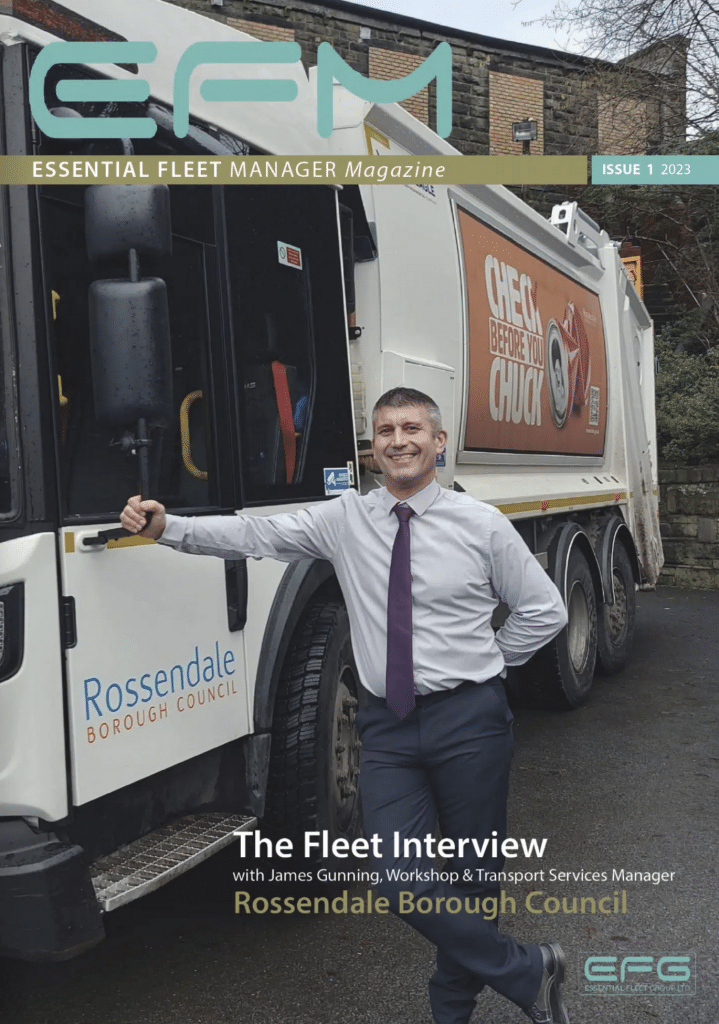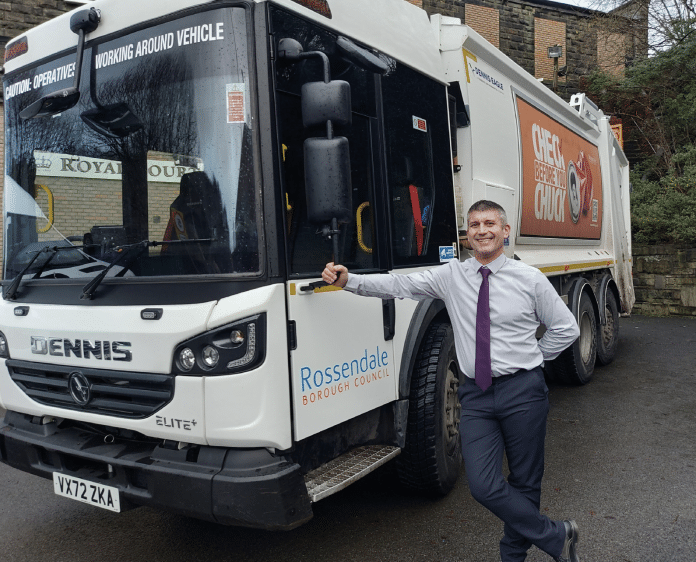With James Gunning, Workshop & Transport Services Manager
Situated in the extreme South-East of Lancashire, Rossendale sits across a large part of the Irwell Valley, with much of the population of around seventy-one thousand living in the towns of Haslingden, Rawtenstall, Bacup and Whitworth. Along with the urban population, there are a number of more remote communities and some challenging terrain, so managing the vehicle fleet that provides essential services throughout the borough is therefore a demanding role. These demands are being met by a team led by James Gunning, Workshop & Transport Services Manager and Essential Fleet Manager spoke with James about how this is being achieved, along with how he is applying an innovative fuel solution to help reduce emissions.
Q: Could you describe and break down your fleet assets prior to October 2021?
Before October 2021, the fleet at Rossendale Borough Council consisted of 51 fossil fuelled vehicles.
15 Refuse collection vehicles
9 Chassis cab pick ups
6 Panel vans
1 Luton Van
1 Caged Tipper
1 Hook lift skip wagon
2 Mini Diggers
3 Tractors
5 Ride on mowers
2 Compact sweepers
1 Truck mounted sweeper
1 JCB Waste master
1 Pool car
2 4×4 pick ups
1 Mayoral car
Since then, we have installed an EV charging station at our office and replaced the Mayor’s car with a fully electric vehicle and we are also awaiting the delivery of a new fully electric Pool car.
We have also replaced a substantial proportion of our fleet with the latest euro 6 stage engine vehicles reducing the Council’s carbon footprint even further.
Q: What are the main vehicle tasks throughout the borough?
Being a single tier council our main service provision within the Rossendale Valley is to remove the waste for private and commercial properties. We deal with fly tipping and keep the cobbled paths and streets clear of debris. In addition we provide a service for our Green Flag awarded parks and open spaces, ensuring play areas are safe and clean with neatly cut fields and football pitches, along with organizing and carrying out burials within our borough.
Q: Are there any particular challenges that need to be met derived from the area that your fleet serves?
We are in the heart of Lancashire and surrounded by hills and valleys. Our heritage of being a mill town is shown in narrow streets with obscure angles, sloping paths and quaint little snickets.
The topography of the land ranges from rows of terraced houses in small market towns to rural outposts. This in turn limits us to the use of certain size Refuse collection vehicles.
When we explored the range of electric Refuse collection vehicle options, we found that the manufacturer only built a rear steering version. This is a problem for us as we still have to use landfill to dispose of our non-recyclable waste and we know the site will not allow rear steering vehicles to enter.
Finding an alternative to the currently available electric options was therefore essential.
Q: Which options did you explore before you decided the direction of your decarbonisation plans?
Upon starting our journey towards decarbonisation we explored various routes which all presented different obstacles.
Electric RCV: Only one manufacturer was able to supply the size of vehicle we needed to navigate the streets of the valley, and at £450,000 per vehicle, the cost was quite high. Additionally, the vehicles were only available with rear steering in electric form, meaning the we could not enter the landfill facilities we use.
Electric Vans: The vans we explored were not able to tow the weight needed to transport our mowing and agricultural equipment. The payloads were also insufficient for our needs.
Electric Sweepers: The technology did not seem suitable and the cost was around £400,000.
Hydrogen: At the time the technology was just being developed and didn’t meet our requirements, as with electric, the costs were high.
Solar: This option was also investigated, it was found that this would give us a 5% saving on fuel by way of reducing the amount of electrical draw from the alternator.
HVO: This is an option that I had extensively researched for approx. 12 months. I started by approaching contacts in the industry to gain knowledge from both sides of the field. I worked closely with our local supplier and vehicle manufactures to ensure that HVO would be a viable and cost-effective alternative to reduce our carbon emissions.
Whilst technology improves, and electric vehicles become more affordable, the use of HVO is helping Rossendale Borough Council to reduce its carbon footprint by 90%, therefore helping to meet the target of being carbon neutral for 2030. It also means we can continue to explore different alternatives to fossil fuel.
Q: What were the issues associated with first generation Biodiesel?
Back in the late 1990s and early 2000s Biodiesel was just making an appearance and claiming to be the super fuel of the future, my personal experience of this is that ‘not all that glitters is gold’.
The fuel’s chemical makeup contains fatty acids and oils which freeze in cold temperatures. For us, this would result in a reduction in the services we could provide, out-of-hours call outs, missed deadlines and overall disruption within the fleet.
The fuel also clogs up fuel systems and fuel filters resulting in extra costs and increased servicing of the vehicles.
Q: How did you trial the feasibility of HVO in practical terms and then justify the extra fuel costs?
The decision to move the whole fleet to HVO was taken after the costs had been calculated and offset against the cost of purchasing electric vehicles.
We calculated that an overspend of £160,000 would be needed to fuel the fleet with HVO for the coming year.
The information gathered was put in a report to the councillors and the directors. The report showed how, for the extra fuel cost, Rossendale Borough Council would be able to decarbonise its whole fleet, reducing carbon emissions by 90% overall. Crucially this extra cost equated to replacing just one diesel RCV with one electric RCV. It would therefore be a quick win for both cost and reducing emissions. This was received and implemented in the new budget year of 2022.
Q: In what stages did you introduce HVO to your vehicle fleet?
After exploring the options available and settling on the direction in which we were going, I contacted the local supplier who I had worked with closely, (Crown Oil in Bury), and organised a separate fuel tank to conduct the trial.
Phase one of the trial started with four frontline Dennis Eagle Refuse Collection Vehicles that were less than six months old. This first phase was scheduled to run for 12 weeks. However, after only eight weeks it was determined that things were going extremely well, having experienced no problems. Therefore, we started to implement phase two with a range of different vehicles, this next trial was set to last for four weeks.
Phase three saw the introduction to the remaining parts of our fleet.
As of March 2022, HVO has been fuelling our whole fleet.
Q: Now that HVO is fuelling your entire fleet, what are the practical benefits?
After monitoring many factors relating to our use of HVO over the last 12 months, I have gained valuable insights. I measured MPG, reliability, servicing costs as well as environmental impact. In summary, the data showed no extra serving costs and the reliability of the vehicles had not been affected. There had also been no impact on MPG figures, the usage of Ad Blue had slightly but not measurable decreased. The cost per litre had increased creating an overspend, but this had been accounted for prior to beginning the trial.
The real positive outcome from the use of HVO fuel is the fact we had previously produced approx. 600 cubic tonnes of greenhouse gasses throughout the fleet and this is now approx. 60 cubic tonnes, moving us firmly towards our goal of achieving zero emissions.
Q: There are slightly varied claims about how much CO2 is saved by using HVO; what is your demonstrated experience?
In my research into the positive gains from using HVO, the scientific data provided by the organisations supplying HVO were key in my decision to move over. Field trials carried out show that HVO produces 33% fewer particles compared to fossil fuels and that Hydrocarbons are down by 30%, carbon monoxide is cut by 24% and Nitrogen oxide (NOx) is reduced by 9%. This is the data I have used to calculate my reduction in emissions using HVO.
Q: How important has it been to remain engaged with both fuel suppliers and with vehicle manufacturers during the process and as you move on?
It is extremely important to keep up to date with fuel suppliers. When we first started trialling HVO there were only a few major suppliers but as time has progressed, there is now a network of five or six suppliers who are able to compete. This enables us to get the best prices and means extra savings for the Council.
It is also important that we work hand-in-hand with the vehicle manufacturers to keep abreast of technology and advancements in alternative fuels.
With the increased use of HVO it is good to share experiences and future advancements in this ever-changing field. As we update the fleet, it is vital that each vehicle or piece of plant is HVO compatible, able to meet our needs, and allows us to continue the journey to decarbonisation.
Q: How is your experience benefitting other Local Authority fleets?
I have been approached by some of the local councils and councillors over the last 12 months asking for help in their own journey to become carbon neutral. I have worked closely with the fleet managers and have been able to provide first hand experiences in the transition and share my preconceptions in the initial stages.
Whilst working together with our local councils, I have been able to form strong networks and extend partnerships. By sharing knowledge with like-minded people, for me, has the added bonus of being both exciting and uplifting. In this process I have helped other fleet engineers and councils to become cleaner and although it is not 100% carbon free, I have demonstrated it is a quick and affordable win.
Q: Does the relatively limited capacity to manufacture HVO mean that it will remain an option only for those fleets with on-site fuel storage facilities? What is the future for HVO alongside the rapid development of BEVs and Hydrogen Fuel Cell vehicles.?
HVO is getting increasingly popular in the UK so the demand is increasing. In terms of supply it is just as good as obtaining fossil fuels, although this certainly wasn’t the case when we started using it 2021, as it was limited to two suppliers at best. We have been lucky to have one of the main suppliers of HVO in the UK on our doorstep. With the help of their expert team we have been able to make the transition with ease.
The main supplier of HVO is a company based in Finland called Neste and they ship across millions of litres per annum and while it is not available at the conventional pump, the need for onsite storage is the only option for now.
Technology is improving all the time and so are the advancements in Battery Electric Vehicles (BEVs) and Fuel cell electric vehicles (FCEVs) as more companies are getting involved with their development. Our main problem still lies with the disposal of waste at landfill, so the current technology is not a realistic option, for the reasons mentioned previously. This, combined with the cost of purchasing the vehicles is just not realistic. I feel there will be a need for HVO for a while yet and certainly until the cost of alternative fuelled vehicles decreases and the technology advances to meet the needs of our fleet.
As featured in Issue 1(2023) of Essential Fleet Manager Magazine – click to view





